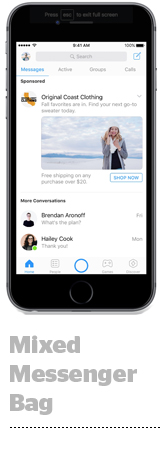
Advertisers and agencies can now buy ads on the Facebook Messenger home screen – but they lack the necessary levers to optimize performance or customize creative.
“We’re recommending to our teams to be aware of the opportunity, but we’re really waiting for the inventory to be unbundled,” said Kieley Taylor, senior partner and head of paid social at GroupM, which hasn’t started testing the format yet, although it has helped clients create bots for Messenger.
For the moment, Messenger ads, which Facebook rolled out to all advertisers on Tuesday after a beta test in Australia and Thailand, can only be bought as part of an inventory package, not as a separate placement.
At minimum, Facebook requires that Messenger inventory be bundled with news feed inventory.
The bundle mandate, which Taylor called a “sticking point,” means that agencies can’t optimize their spend based on performance.
Although the reporting shows how a Messenger ad is performing compared with a news feed ad, for example, there’s nothing an advertiser or agency can do with that information.
“If a Messenger ad is performing really well, you can’t put more dollars toward that, just to the aggregate,” Taylor said. “My assumption is that there will be [fewer] impressions as they start to roll this out and it gains traction over time, but it is a frustration for now to see that something may or may not be doing well and then not being able to optimize and vote with our dollars.”
Being required to bundle the buy also means agencies can’t customize KPIs or the creative they run on Messenger. To start, Facebook will only support traffic and conversion objectives, although it has plans to roll out more options, including an app-installs KPI, in the near term.
“The ads are somewhat limited right now to advertisers with certain objectives,” Taylor said. “But we also have plenty of advertisers interested in delivering unique reach for higher-funnel and awareness objectives.”
It becomes “a bit of slippery slope” when the placement is dictated on predetermined outcomes rather than allowing the agency to identify the best fit based on the role of the channel or site, Taylor said.
Although the move to monetize Messenger makes perfect commercial sense, the creative execution, or lack thereof, also leaves something to be desired, said Mediacom vet Jon Hook, currently VP of brand and agencies at AdColony.
“The thing that irritates me is that Facebook has got to know more than any other company about me, but at a time when the hot topics are opt-in and nonintrusive, relevant advertising, what do they do? Stick an ad on my home screen,” Hook said. “Granted, they’re probably very well targeted based on something I like, but if anyone is in a position to release an impactful, permission-based ad unit, it’s Facebook. This needs to look different than the standard.”
Regardless, Messenger is “a welcome addition to Facebook’s ad arsenal, and brands should take notice,” said Justin Marshall, VP of emerging media at Possible, and not just because of the increased inventory.
With Messenger ads, Facebook is sending the message that it “wants to be considered as an ecosystem that connects people to brands both pre- and post-purchase,” Marshall said.
This post was syndicated from Ad Exchanger.

More Stories
The Tobacco-Free Future of Phillip Morris With Marian Salzman
WBD Introduces Out-of-Home Member Plan as It Begins Max Password Crackdown
Deep Blue Is Building a Women’s Sports Yacht Club at Cannes